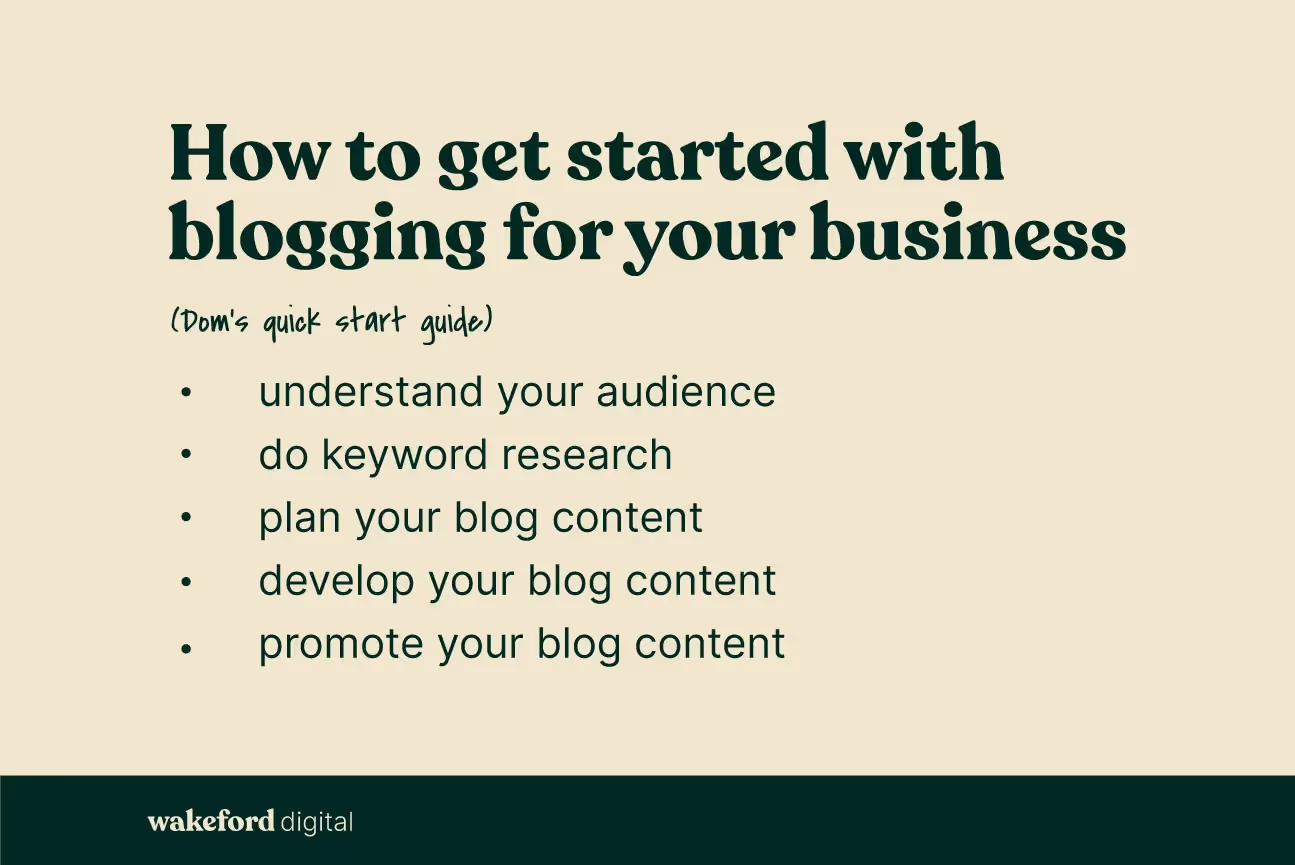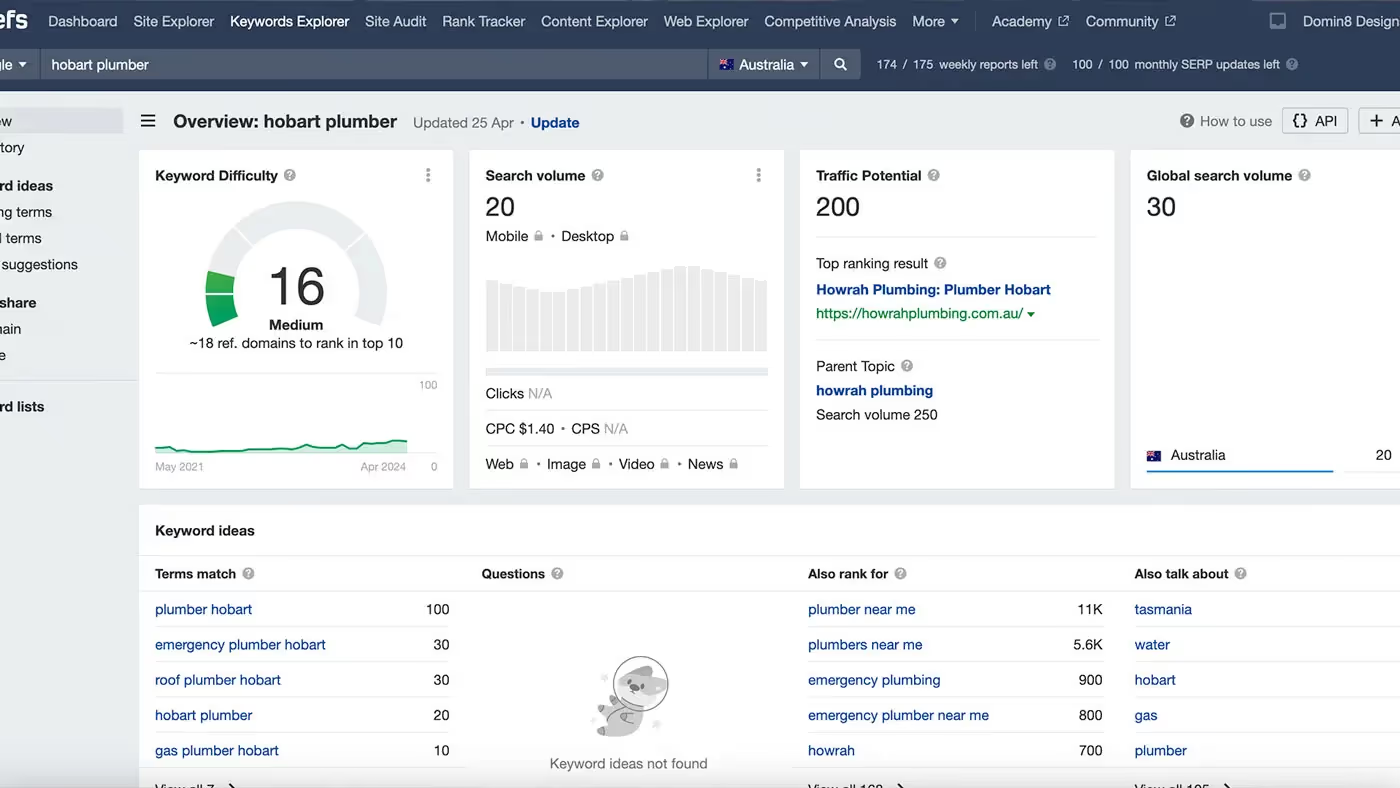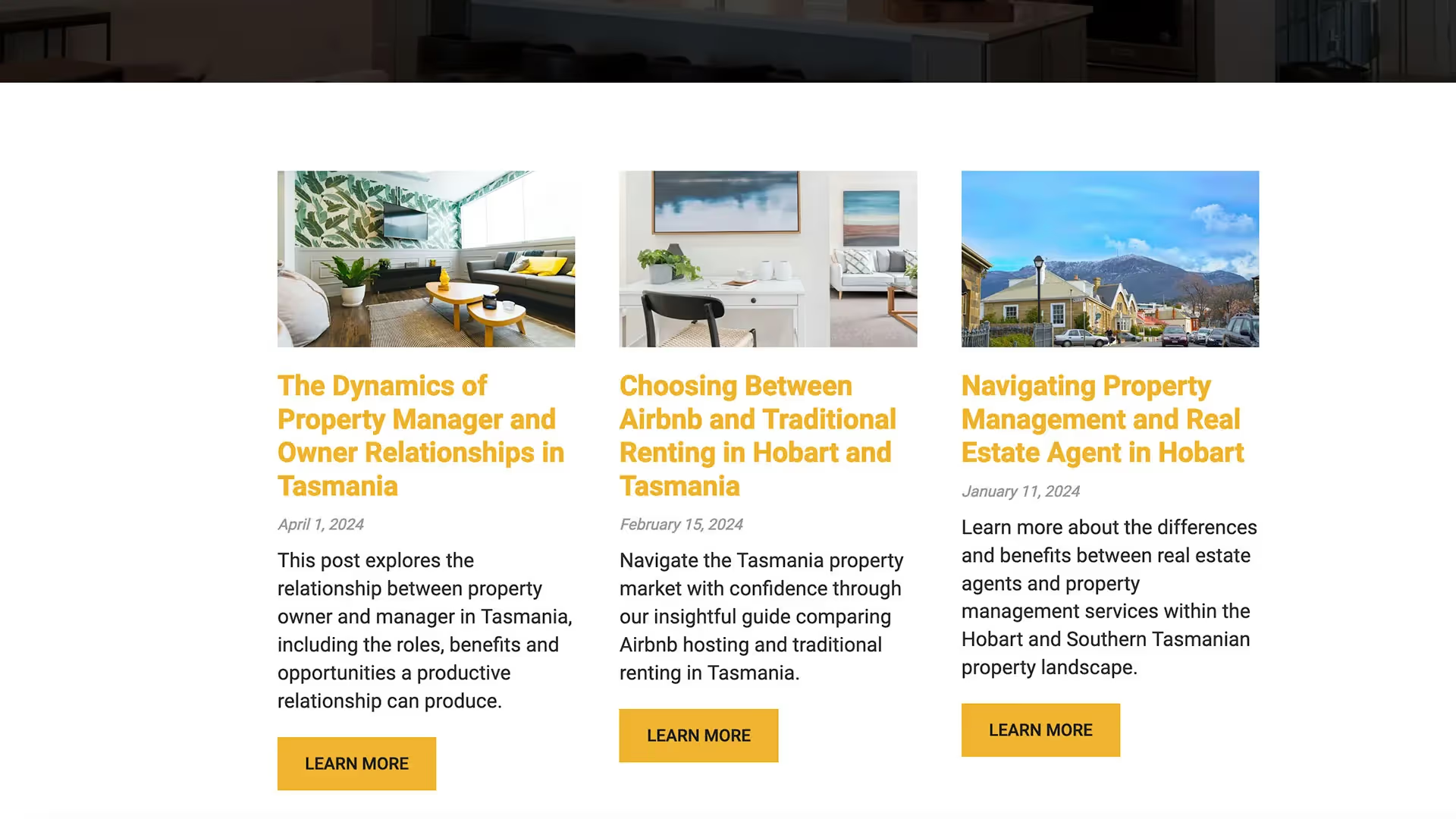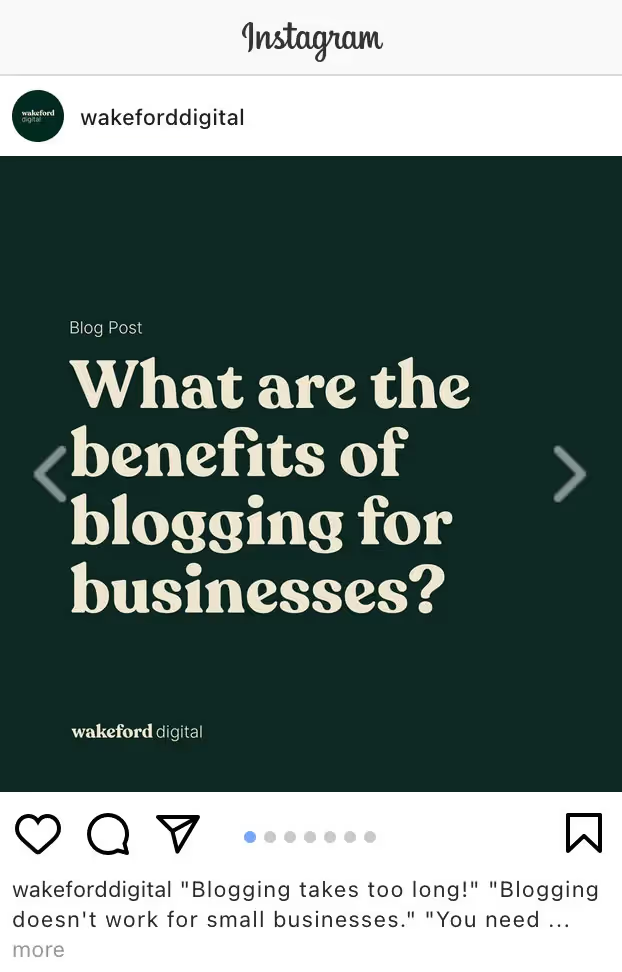Blogging often catches a bad rap...
There’s a lingering notion that it's a labyrinth of time and effort, with rewards too distant on the horizon.
Some think it’s all about churning out content. Some thing it's just for the sake of stuffing keywords while others say it’s an outdated strategy in the whirlwind of digital marketing options.
However, here at Wakeford Digital, we believe this couldn’t be further from the truth.
Particularly among the Tasmanian business landscape, blogging emerges not just as a tool but an opportunity for growth and visibility online; especially for brand awareness or search engine optimisation.
Wakeford Digital owner Dominic says, “Blogging can be a really valuable resource in weaving stories that resonate with your community while sharing insights that matter - connecting with the people that are most likely going to listen and engage with that content.”
When business blogging is combined with strategic web design, localised SEO and video efforts, it goes beyond misconceptions - proving to be a valuable asset for businesses aiming to carve their niche both in the local market and beyond.
In this guide, we'll debunk myths around small business blogging and show the path to leveraging blogging effectively.
From enhancing your business web design experience to mastering elements like SEO in Hobart, we’ll show you how blogging can be one of your small business’s best assets...
Want a more detailed version? Check out our video on the ultimate guide to small business blogging in the player below.
Simply put, a blog is a collection of articles on a website, regularly updated and usually arranged in date order.
It's where businesses share everything from how-to guides and industry insights to company news and personal stories.
Each blog post is a chance to speak directly to your audience, offering value and establishing your presence in the digital world.

Blogging has a range of often overlooked benefits, particularly when it comes to small business website design in Hobart and Tasmania.
The benefits of blogging include:
Blogging is a critical component of any comprehensive SEO strategy - particularly for businesses in Hobart and Tasmania.
Simply put - regularly publishing fresh, keyword optimised content helps improve your website’s visibility in search engine results, thus driving targeted traffic to your site.
By sharing in-depth knowledge and industry insights, your blog positions your business as an expert in your field. This credibility is essential for attracting new customers and retaining existing ones, as people tend to do business with companies they trust.
A blog is not just a broadcasting platform, it can also act as a a community hub - something that is very (very!) important given Tasmania’s close knit working relationships.
Spending time on a blog may encourage interactions through comments, social media shares, and discussions; allowing you to engage directly with your audience.
Beyond SEO benefits, informative blog posts encourage your ideal customers to both visit and to spend more time on your website, reducing bounce rates (i.e. people leaving after only visiting one page) and increasing the likelihood of conversions.
High-quality, valuable blog content is also more likely to be linked to by other websites - something that is often hard to do. These backlinks, especially if from a reputable website, not only drive referral traffic but also enhance your site's authority in the eyes of search engines, further improving your SEO Hobart.
Every blog post provides content that can be shared across social media platforms, extending your reach, increasing brand awareness, and driving traffic back to your website.
--
Blogging often faces skepticism, particularly from small business owners who might view it as an outdated or time-consuming strategy.
Despite its proven effectiveness, several myths persist that can deter businesses from leveraging this powerful tool, which include:
Having a blog is too time consuming!
While blogging does require a commitment of time and resources, the return on investment can be significant. With proper planning and a good content strategy, blogging can be efficiently managed and become a cornerstone of your digital presence.
You need to write a daily blog to be effective.
Frequency can undoubtedly help when it comes to blogging, but consistency and quality are far more important. A well-written, informative blog post once a fortnight can be more effective than daily posts that don’t provide value.
Writing a blog doesn’t lead to actual business results, does it?
Blogs are powerful tools for driving traffic, generating leads and establishing authority. They play a crucial role in nurturing relationships with customers and influencing purchase decisions.
Only a bigger business can benefit from blogging!
We actually find the opposite here at Wakeford Digital, where small businesses can see substantial benefits from blogging and often take it up to the big guys. Blogging becomes an excellent way for them to level the playing field and enhance their visibility against larger competitors.
SEO for blogs is too complex and I don't have time.
While SEO might seem intricate, basic principles such as using relevant keywords, creating quality content, and optimising for mobile are manageable for anyone with the right guidance and tools.
By understanding what blogging truly involves and the tangible benefits it offers, businesses can more effectively utilise this tool to achieve their marketing objectives and grow their audience.
Now that we understand the benefits of blogging, you might be thinking of starting a blog that can improve the online presence of your business - so how do we get started?
--
If you're ready to harness the power of blogging to boost your small business in Tasmania, here’s a concise guide that walks you through from ideation to promotion:

Begin by gaining a deep understanding of who your readers are -what are their needs, challenges, and interests? Use tools like surveys, social media interactions, and customer feedback to gather information.
One system that might help this process is developing 'personas' for your idea or likely website visitors - create detailed customer profiles that reflect the characteristics of your ideal customers.
These personas will guide you in tailoring your content to meet the specific needs and preferences of your audience.
Tools and techniques are also an often overlooked component for small businesses when it comes to blogging.
While writing whatever comes to mind can resonate with your audience, this sort of focus often loses its way and isn't backed with any data or research.
Use keyword research tools like Google Keyword Planner, Ahrefs, or SEMrush to find keywords that your target audience is searching for. Focus on those that are relevant to your business and have a reasonable search volume.
Dom's Tip: long-tail keywords - incorporating long-tail keywords, which are less competitive and more targeted keywords, can be a fantastic way of increasing your chances of attracting qualified traffic.

As previously mentioned, planning your blog content through strategies like a content calendar can help keep structure and routine.
Your content calendar should outline when and what you will post, aligning with key business dates, product launches, or seasonal events relevant to your audience.
Topic clusters can also really help further make blogging easier - that is, organising your content around topic clusters that cover various aspects of your core themes.
This approach helps in creating a comprehensive resource hub for your readers and boosts your SEO by covering related topics extensively.

Next up is actually developing content for your blog - and this can start with determining content types.
Decide on the types of content that will best engage your audience, such as how-to guides, infographics, video tutorials, or in-depth analyses.
Then, you can get writing - focus on creating high-quality content that provides value.
Dominic says, "Particularly for small businesses who may just be starting out, one highly valuable content piece targeting a long-tail keyword can be more beneficial than 3 short, low value pieces."
"While we still advocate for three blog posts to get started, it's really important that these posts provide your visitors with value - more so than what your competition are doing."
Make sure your posts are well-written, clearly formatted, and include visuals to break up the text and add interest.
An often overlooked component of blogging for small businesses is promoting your actual posts.
While gaining organic SEO traffic from your blog posts is fantastic, developing a high-quality article and promoting this properly can often be more beneficial than developing ten crappy posts.
Leverage your existing or new social media platforms to share your content and engage with your followers.
This includes customising your posts for each platform (i.e. don't use the post to both feature to post to both Instagram and Facebook) to maximise both reach and engagement.
When your businesses reaches a point too, strategies such as email marketing can also help increase your reach and also get your content into the hands (or eyes) of those who are most likely to read it - your subscribers.
Dominic says, "We've recently taken the next step in our Trout Tales Tasmania case study of developing a newsletter list to both create a community but also further disseminate content such as the videos and blog posts, seeing great success as you know they're an audience who will actually engage and interact with the content."

With our quick run down of getting into blogging ticked off, if you're interested in taking the first few steps of blogging for your small business, here's some helpful tips...
--
Starting a blog for your small business involves more than just writing about your products or services; a strategic planning and a structured approach to content creation can make a big difference to ongoing success.
With a small business mindset, the team here at Wakeford Digital have listed some ways to lay a strong foundation for your blog, as well as maintain consistency and quality outputs. These include:
As mentioned previously, well-planned content calendar is a crucial and likely first step to keeping your blogging efforts organised and focused.
This calendar should map out when and what you’ll post, based on various themes or content pillars that align with both your business goals and customer interests.
Developing content pillars can really help with this step - some top level themes that define your business and then topics underneath each of these. For example, our client the National Assistance Card has pillars including; about the card, card benefits, eligibility etc and under these sit a range of topics and assets - each offering a blog topic.
Wakeford Digital owner Dominic suggests, “Setting aside a regular time each week to write your blog post, like Monday morning before starting work or Sunday evening. It's about making blogging a routine part of your business activities.”
"How many posts do I need to get started?"
Dominic suggests a strategic launch approach: “We advocate for a minimum of three blog posts to get started, often releasing two initially then one the week later.” He adds that maintaining a rhythm, such as posting once every fortnight, can be effective if posts are targeted and well-crafted.
Another important tip is to experiment with various blog formats to discover what truly engages your audience.
This might include formats such as:
The right format for your blog posts will capture and hold the interest of your readers.
Dominic advises keeping things manageable: “Don't try to bite off more than you can chew; keep it straightforward and reflect on search intent - i.e. crafting the type of content to what the user is searching.”
This approach can help maintain a sustainable blogging routine without overwhelming you or your team.

Getting feedback on your blog posts before they go live can lead to significant improvements in quality, as well as giving you the confidence to know you’re on the right track.
Dominic recommends involving others in the review process: “Get a colleague, family member, or friend to read over the first few posts to give some honest feedback and insight.”
This step can be invaluable as it provides an external perspective on how your content may be received by your audience and ensure that the take aways you want are being achieved.
Again, as above, small businesses can often struggle to come up with consistent and regular content to post on social media - and this is where we say ‘enter blog content’.
Dominic points out the versatility of blog content in supporting social media strategies: “A blog post can be repurposed in multiple ways to provide at least a week if not a month's worth of content.”
For example, from this blog post we can chop it into a few different posts including:
This repurposing enhances the utility of each blog post, stretching the value of your content across multiple platforms and increasing engagement.

An important caution from Dominic highlights the authenticity factor in blogging: “As a small business owner, we’re often caught up in the day to day activities of running the business and as such, AI appears as a silver bullet for our blogging problems - but this couldn’t be further from the truth and is a trap.”
“At Wakeford Digital, we recommend avoiding using ChatGPT to write full blog posts; search engines like Google will recognise and potentially punish these, ultimately undoing all your blogging efforts, and readers will likely easily know this is an AI written post.”
Ensuring that your content is original and genuinely reflective of your brand’s voice is key to building trust and authority with your audience.
By implementing these steps, small business owners can effectively launch and sustain a blog that not only boosts their SEO but also enhances customer engagement and supports broader marketing goals.
As a summary, Dom’s tips include:
--
By following the above steps, you can effectively set up and maintain a blog that not only attracts but also retains and converts your target audience.
Remember, the key to successful blogging is consistency, quality, and ongoing engagement with your readers.
With the right strategy, your blog can become a significant asset in your business’s marketing toolkit.
Overall, while blogging does take time, strategies such as a good content plan, a consistent writing format and good promotion of your posts can drastically reduce the effort required and you'll start seeing exponential benefits.
We hope you've taken some value out of our ultimate guide to blogging for small businesses - and if you've got any further questions, please don't hesitate to get in touch with us here at Wakeford Digital.

